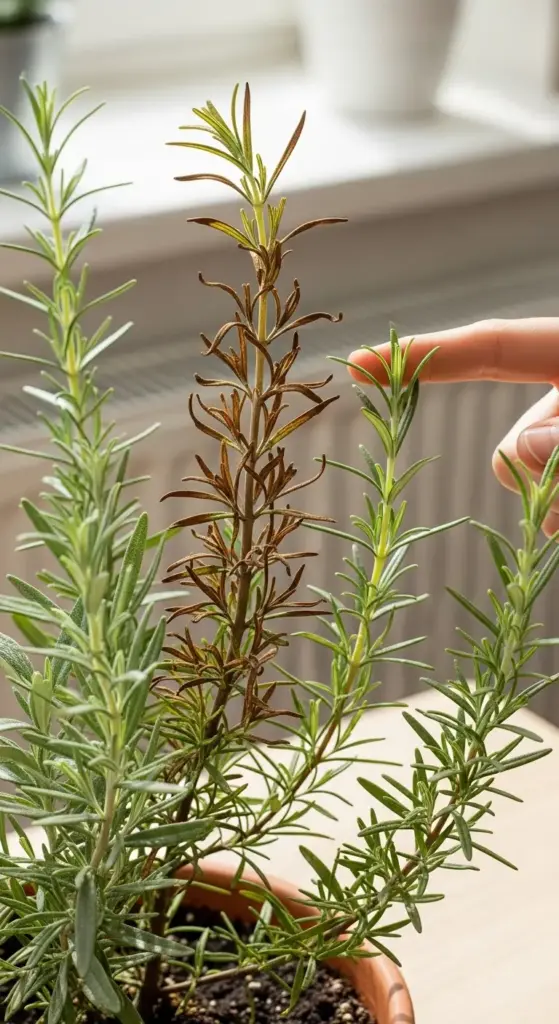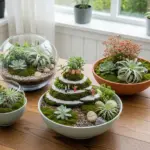5. Brown, Crispy Leaf Tips and Edges

The first time I saw those brown, crispy leaf tips on my rosemary, I was convinced I wasn’t watering enough. So naturally, I doubled down on the watering schedule and watched in horror as more leaves developed those telltale brown edges.
Turns out, I was completely wrong about what was causing it. Those crispy tips weren’t screaming for more water – they were basically my plant’s way of saying “help, something else is wrong here!”
Distinguishing Between Underwatering and Fertilizer Burn
Here’s where I made my biggest mistake: assuming all brown leaf tips meant the same thing. Underwatering damage and fertilizer burn look almost identical at first glance, but they tell completely different stories.
Underwatering brown tips usually come with other signs – the whole leaf looks dull, the soil pulls away from the pot edges, and the plant feels lighter when you lift it. The browning happens gradually over several days.
Fertilizer burn is more dramatic. The tips turn brown almost overnight, and there’s often a yellowish halo around the brown areas. The soil might have white crusty deposits on the surface too.
I learned this the hard way when I over-fertilized my favorite rosemary plant. Within 48 hours, nearly every leaf had brown, crispy edges that looked like they’d been singed with a tiny blowtorch.
The smell test works here too. Fertilizer burn often comes with soil that smells chemically or overly salty when you dig into it.
How Indoor Heating Affects Rosemary in Winter
Moving to Chicago taught me everything I never wanted to know about indoor heating damage. Those brutal winters mean cranking up the heat, and rosemary absolutely hates the dry, hot air that blasts from heating vents.
Forced air heating is the worst culprit. I had my rosemary sitting near a heating vent, thinking the warmth would make it happy. Instead, it looked like someone had taken a hair dryer to every single leaf.
Minneapolis winters were even worse because the heating systems run constantly for months. The air gets so dry that even humans need humidifiers, let alone poor Mediterranean plants that prefer moderate conditions.
Radiator heat isn’t much better. I thought it would be gentler, but those hot, dry air currents rising from radiators created the same crispy leaf problem.
The temperature fluctuations don’t help either. During the day, the heat blasts and creates desert-like conditions. At night, temperatures drop and humidity changes again. Rosemary plants hate that kind of instability.
The Role of Humidity in Preventing Leaf Tip Burn
Humidity levels became my obsession after losing three rosemary plants to crispy leaves. Turns out, rosemary needs about 40-50% humidity to stay happy, and most heated homes in winter drop to around 20-30%.
I bought a cheap humidity meter and was shocked to discover my apartment was basically a desert during heating season. No wonder my poor plants were struggling!
Low humidity causes plants to lose moisture through their leaves faster than their roots can replace it. The leaf tips are the first casualties because they’re the farthest from the water source.
Dry air also makes plants more susceptible to other problems like spider mites and powdery mildew. It’s like their natural defenses get compromised when they’re constantly stressed about moisture loss.
The good news? Increasing humidity around your rosemary can prevent most leaf tip browning, even if your watering and fertilizing are perfect.
Natural Ways to Increase Humidity Around Your Plant
Pebble trays became my go-to solution after trying about a dozen different methods. Fill a shallow tray with pebbles, add water until it’s just below the top of the stones, then set your pot on top.
The key is making sure the pot bottom doesn’t sit in water – you want the evaporation without the root rot risk.
Grouping plants together creates a natural humidity bubble. I cluster my herbs on one side of the kitchen where they can share moisture from each other’s transpiration.
Bathroom growing works great if you have a window there. All those showers create perfect humidity levels for rosemary, especially during dry winter months.
Misting is tricky with rosemary because wet leaves can lead to fungal problems. If you do mist, do it early morning so leaves dry quickly, and never mist in humid weather.
DIY humidifiers work too. I keep shallow bowls of water near my plants and change them weekly. Not as effective as pebble trays, but better than nothing.
Fertilizer Schedules That Won’t Damage Your Herbs
This is where I went completely overboard in my early gardening days. I thought more fertilizer meant healthier plants, so I was feeding my rosemary every two weeks with full-strength plant food.
Big mistake. Rosemary fertilizer needs are actually pretty minimal. These plants evolved in poor Mediterranean soil, so they’re not expecting a constant buffet of nutrients.
Spring feeding is usually enough – one light application of balanced fertilizer when new growth starts appearing. I use half the recommended strength because rosemary is sensitive to fertilizer burn.
Summer feeding should be even lighter, if at all. I might give a very diluted liquid fertilizer once mid-summer, but only if the plant looks pale or growth seems slow.
Never fertilize in fall or winter. The plant is going dormant and can’t process the nutrients properly. That’s when salt buildup happens and causes those crispy brown tips.
Organic options work better for herbs you’re planning to eat. Compost tea, fish emulsion (diluted), or worm casting tea are gentler and less likely to cause burning.
Watch for white crusty buildup on the soil surface – that’s excess fertilizer salts and a sure sign you’re overdoing it. Flush the soil with plain water if you see this happening.
Container plants need even less fertilizer because nutrients don’t leach away as quickly as they do in garden soil. I learned this after killing a perfectly healthy rosemary with kindness and too much plant food.
Think brown tips are bad? Click “next” to discover why your rosemary might be turning pale and refusing to grow – and the container mistake that keeps most indoor herb gardens stunted and sad!









GIPHY App Key not set. Please check settings